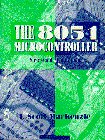The 8051 microcontroller / I. Scott MacKenzie.
Material type: TextLanguage: English Publication details: New Jersey : Prentice Hall, 1995Edition: 2daDescription: 356 pContent type:
TextLanguage: English Publication details: New Jersey : Prentice Hall, 1995Edition: 2daDescription: 356 pContent type: - texto
- sin mediación
- volumen
- 0023736607
| Item type | Current library | Call number | Status | Barcode | |
|---|---|---|---|---|---|
 Libros
Libros
|
Facultad Regional Santa Fe | 004.3'144 M119 (Browse shelf(Opens below)) | Available | 7407 |
Browsing Facultad Regional Santa Fe shelves Close shelf browser (Hides shelf browser)
CONTENIDO
Chapter 1. INTRODUCTION TO MICROCONTROLLERS 1
Terminology 3
The Central Processing Unit 3
Semiconductor Memory: RAM and ROM 5
The Buses: Address, Data, and Control 6
Input/Output Devices 7
Programs: Big and Small 8
Micros, Minis, and Mainframes 9
Microprocessors vs. Microcontrollers 10
New Concepts 12
Gains and Losses: A Design Example 13
Chapter 2. HARDWARE SUMMARY 17
MCS-51 Family Overview 17
Once Around the Pins 19
I/O Port Structure 22
Memory Organization 22
Special Function Registers 26
External Memory 32
8032/8052 Enhancements 37
Reset Operation 38
Chapter 3. INSTRUCTION SET SUMMARY 43
Addressing Modes 43
Instruction Types 50
Chapter 4. TIMER OPERATION 63
Timer Mode Register (TMOD) 64
Timer Control Register (TCON) 66
Timer Modes and the Overflow Flag 66
Clocking Sources 68
Starting, Stopping, and Controlling the Timers 69
Initializing and Accessing Timer Registers 71
Short Intervals and Long Intervals 72
8052 Timer 2 76
Baud Rate Generation 78
Chapter 5. SERIAL PORT OPERATION 81
Serial Port Control Register 81
Modes of Operation 82
Initialization and Accessing Serial Port Register 87
Multiprocessor Communication 88
Serial Port Baud Rates 89
Chapter 6. INTERRUPTS 97
8051 Interrupt Organization 98
Processing Interrupts 100
Program Design Using Interrupts 102
Serial Port Interrupts 107
External Interrupts 109
Interrupt Timings 113
Chapter 7. ASSEMBLY LANGUAGE PROGRAMMING 117
Assembler Operation 118
Assembly Language Program Format 120
Assemble-Time Expression Evaluation 125
Assembler Directives 129
Assembler Controls 138
Linker Operations 140
Annotated Example: Linking Relocatable Segments and Modules 141
Macros 148
Chapter 8. PROGRAM STURCTURE AND DESIGN 155
Advantages and Disadvantages of Structure Programming 157
The Three Structures 158
Pseudo Code Syntax 171
Assembly Language Programming Style 174
Chapter 9. TOOLS AND TECHNIQUES FOR PROGRAM DEVELOPMENT 181
The Development Cycle 181
Integration and Verification 185
Commands and Environments 189
Chapter 10. DESIGN AND INTERFACE EXAMPLES 193
The SBC-51 193
Hexadecimal Keypad Interface 199
Interface to Multiple 7-Segment LEDs 201
Loudspeaker Interface 205
Non-Volatile RAM Interface 208
Input/Output Expansion 215
Analog Output 217
Analog Input 222
There are no comments on this title.





